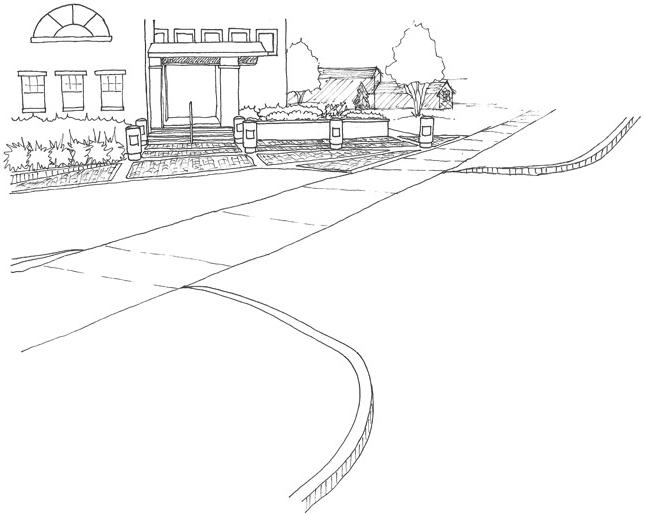|
  |
Site Access
Providing safe, efficient pedestrian and vehicular access that complements topography and natural features is an essential component of site design. Site access involves the transition between major circulation routes and parking areas, between regional trail systems and a building’s front door. Vehicular traffic proceeds from roadways to parking spaces via acceleration and deceleration lanes, limited access roads, shared access drives, and parking lot drive lanes. Site access also involves trails, sidewalks, crosswalks, bus stops and taxi stands, and bicycle parking areas. These elements facilitate entering a site from an adjacent property or another county.
|
|

Sidewalk provides safe pedestrian access across vehicular entrance, Leelanau County
|
|
Access to Developments
Designing a site’s road network and access points requires minimizing the number of curb-cuts (i.e., driveways) while providing interconnectivity between adjacent properties. Keeping curb-cuts to a minimum facilitates off-site traffic flow and helps preserve the regional character. Incorporating multiple access points (e.g., roads, alleys) whenever possible provides more circulation options, enhances emergency service access, and reduces vehicular flow at any one given point – especially near the collector street in cul-de-sac developments. The use of loop roads (i.e., two access points) and the connection of adjacent streets should be encouraged.
The design of new sites adjacent to established neighborhoods should pursue methods of enhancing vehicular and pedestrian connectivity between the properties. Some developments have connected roadways with removable or retractable bollards for emergency and service vehicle access between developments. Connecting the roadways allows access for pedestrians and bicyclists, while the bollards prevent most vehicular traffic.
Whenever topography permits, site design should include connections with neighboring properties and regional trail networks. Pedestrian access includes provision of appropriately placed, well-lit sidewalks or pathways between parking areas, building entrances, the street, and adjacent properties.
|
|
|

Pedestrian access to Oleson's Plaza West, Grand Traverse County
|
|
Access Roads, Alleys, & Shared Driveways
Frontage roads, alleys, service drives, and shared driveways are desirable methods of accessing a site and may provide alternative access to the site for emergency vehicles. They simplify roadside visual character and minimize conflicts and hazards, as well as increase on-street parking options. Placing parking areas behind buildings also increases green space and makes fewer and smaller signs more practical. Refer to Critical Design Practices: Creating Usable Open Space and Sign Design & Placement for additional information.
|
|
|

Retractable bollards allow pedestrian, bike, and emergency vehicle access
|
|
Key Points:
- Ingress and egress needs of the various users should be considered during site planning.
- Alleys and shared roadways minimize curb-cuts (i.e., access points, driveways). Parking behind and beside buildings also reduces vehicular traffic through the pedestrian areas.
- Linking parking lots and providing shared roadway access whenever possible facilitates ease of access between adjacent properties, increases efficiency in parking lot layout, and reduces the amount of paved area.
- Site entries should be clearly marked, and, when pedestrian and vehicular traffic intersect, the vehicular traffic should yield to pedestrians whenever possible. Refer to Critical Design Practices: Pedestrian & Bike Circulation for more information.
- The minimum distance between a site’s vehicular access points and road intersections should be two hundred (200) feet wherever possible.
- Where limited access is desirable connecting roadways between adjacent neighborhoods and installing bollards provides for pedestrian and bicycle circulation while restricting through-traffic to emergency vehicles.
- Design ingress and egress for trucks and service vehicles for loading and unloading materials, as well as accessing appropriate parts of a site.
|
|
